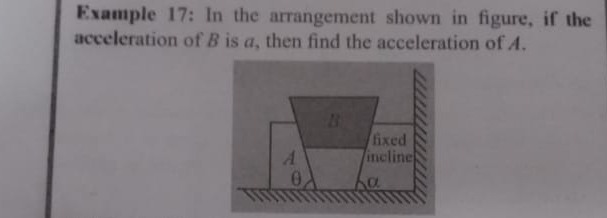Question
Question: In the arrangement shown in figure, if the acceleration of B is a, then find the acceleration of A....
In the arrangement shown in figure, if the acceleration of B is a, then find the acceleration of A.

A
sinθasin(θ−α)
B
cosθacos(θ−α)
C
sinθasin(θ+α)
D
cosθacos(θ+α)
Answer
The acceleration of A is sinθasin(θ−α).
Explanation
Solution
Let the acceleration of block A be aA=aAi^. Block B moves along an inclined plane with acceleration aB=a(cosαi^−sinαj^). The acceleration of B relative to A is aB/A=aB−aA=[acosα−aA]i^−[asinα]j^. The unit normal vector to the contact surface is n^=−sinθi^+cosθj^. For no slipping, aB/A⋅n^=0. ([acosα−aA]i^−[asinα]j^)⋅(−sinθi^+cosθj^)=0 (acosα−aA)(−sinθ)+(−asinα)(cosθ)=0 −acosαsinθ+aAsinθ−asinαcosθ=0 aAsinθ=a(cosαsinθ−sinαcosθ) aAsinθ=asin(θ−α) aA=sinθasin(θ−α)
